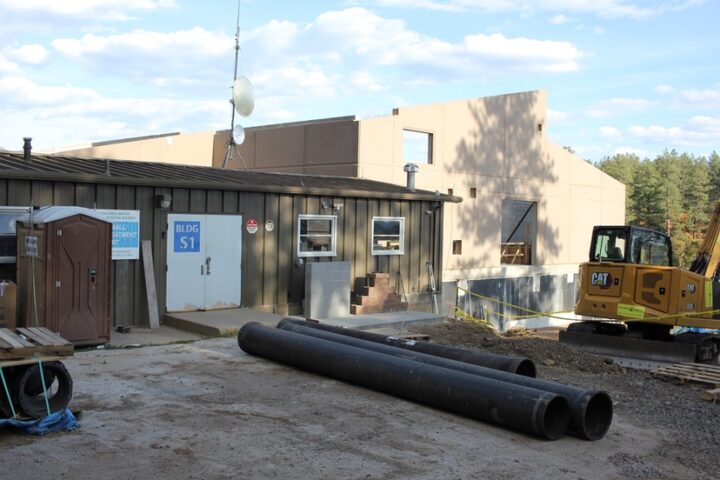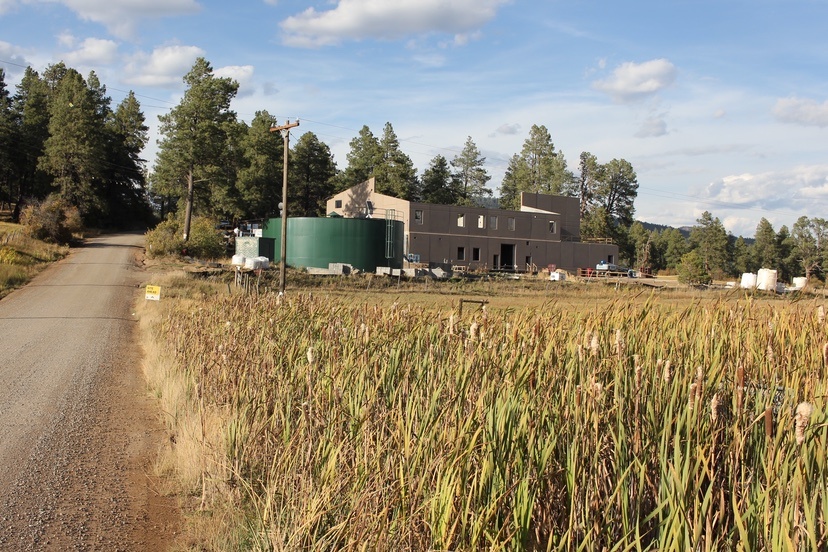Photo: The new Snowball Water Treatment Plant, under construction. October 2024.
I took a drive out Snowball Road last week, to take photos of the new water treatment plant under construction… almost $45 million dollars worth of engineering, concrete, pipes, and high-tech water treatment infrastructure. A big chunk of the cost has been covered by grants and District reserves, but Pagosa Area Water and Sanitation District (PAWSD) customers will be paying off a $33.4 million loan for the next 30 years.
I believe this is the most expensive local government project ever attempted in Pagosa Springs. More expensive than the Stevens Field airport expansion, the new County jail, the Town’s seven-mile sewer pipeline.
Disclosure: I currently serve as a volunteer on the PAWSD Board of Directors, but this editorial reflects only my own opinions, and not necessarily the opinions of the PAWSD organization as a whole.
I also took a photo showing the old, existing water treatment plant next door — a much smaller building that uses what we might call “old fashioned” treatment technology, and is now wasting about 50% of its treated water for ‘back-flushing’ the treatment media.

The new plant will be able to deliver as much as three times the amount of treated water, per day. For a community growing at less than 2% per year — that ought to cover PAWSD water demand in District 2 for at least 80 years, at our current rate of growth.
The raw water at Snowball comes from a diversion point located near the confluence of the East and West forks of the San Juan River… some of the cleanest water in the U.S., in my unscientific estimation. PAWSD has water rights allowing the diversion of up to 5 CFS (cubic feet per second) but the old Snowball treatment facility was typically able to treat less than half that amount.
5 CFS amounts to about 3,600 acre feet per year. PAWSD currently sells about 1,300 acre feet per year to its customers. But most PAWSD raw water — serving District 1 uptown — comes from Fourmile Creek and is treated at the Hatcher Lake treatment plant. PAWSD is currently working on plans to triple the amount of water available at Hatcher, as well.
So let’s sit down with the San Juan Water Conservancy District (SJWCD) board of directors, at last night’s meeting, and hear what they have to say about the Running Iron Ranch — the 667-acre ranch purchased in 2008 by PAWSD and SJWCD as the future site for a water reservoir.
The PAWSD board decided in 2013 not to invest customer revenues into building that reservoir project, but has nevertheless been repaying the $9.2 million loan used to purchase the ranch property. PAWSD has lately been considering the sale of the ranch — to get out from under the loan payments of $250,000 a year — and has received interest from potential buyers.
SJWCD continues, meanwhile, to develop long-range plans to build a massive 11,000 acre-foot reservoir on the ranch.
We have two water districts who can’t seem to find common ground… and who are not telling the same story.
Of course, there are certain facts that the two districts can agree upon. But when the story involves anything about Pagosa’s water future, the disagreements kick in.
The current PAWSD Board of Directors received a report from its finance department, showing that — taking into account the interest and penalties written into a 2015 agreement with Colorado Water Conservation Board (CWCB) — PAWSD would owe about $10.2 million to CWCB if they chose to sell the Running Iron Ranch within the next few months.
But part of the story concerns whether PAWSD can in fact sell the Ranch without first filing a lawsuit against SJWCD to confirm PAWSD’s right, according to the CWCB agreement, to sell the property “at its sole discretion”.
PAWSD Attorney Marcus Lock sent SJWCD a letter requesting affirmation of that right, and suggesting that a refusal to affirm that right, might result in a lawsuit.
At last night’s SJWCD Board meeting, SJWCD closed their doors to the public for an executive session with their attorney Jeff Kane — as they are legally allowed to do — and following the executive session, voted to send a response letter to PAWSD.
Based on the comments made by SJWCD President Candace Jones prior to the vote, I assume the response letter does not affirm PAWSD’s right to sell the property. But that’s an assumption, because the letter was not shared publicly at last night’s meeting.
An excerpt of her comments:
“In addition to responding to that letter [from PAWSD] there’s a lot we have to say, that we’re not gonna send in a letter, and have lawyers trading letters. That’s not an effective way to have a community conversation about this project.
“It’s unfortunate that there haven’t been more discussions between the organizations. We have a committee set up to hopefully kind of encourage those kinds of conversations. Unfortunately, it didn’t work…”
I’m not sure why Ms. Jones states here that “Unfortunately, it didn’t work”. The PAWSD Running Iron Ranch subcommittee and the SJWCD Running Iron Ranch subcommittee have held at least three joint meetings in recent months, and ideas, priorities and facts have been shared back and forth. I attended those meetings on behalf of PAWSD, and found them to be useful.
I’ve also regularly shared information and ideas with the SJWCD Board at their meetings, speaking as a member of the public. I did so again, at last night’s meeting. Unfortunately — since we are talking about unfortunate things — I’ve rarely felt that my information and ideas were appreciated by the SJWCD Board.
But Ms. Jones seems to have ideas about “an effective way to have a community conversation”.
She continued:
“We all are familiar, in this season, with misinformation and disinformation. And we need to find effective ways to have effective communication and conversations with people in this community, to understand what’s happening, and be as factual as we can.
“This [CWCB agreement] that we’re talking about is posted on our website, so if anybody wants to see it and read it, can see it. It’s out there. It’s not secret, at all.”
The CWCB agreement has been shared in past Daily Post articles as well, and in PAWSD meeting documentation. You can download it here.
It’s not secret, at all.
And right there, you have the evidence that we can indeed agree on certain facts.
What’s much harder to agree on? Opinions.

